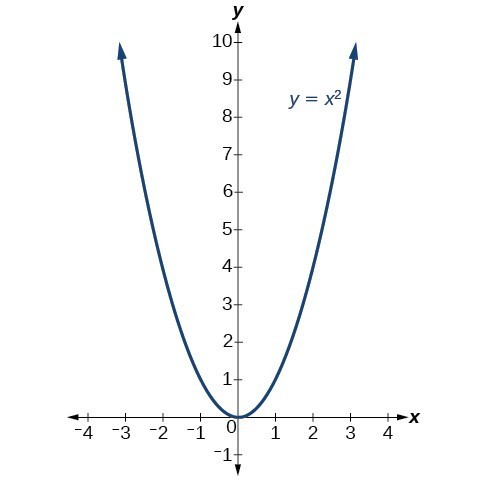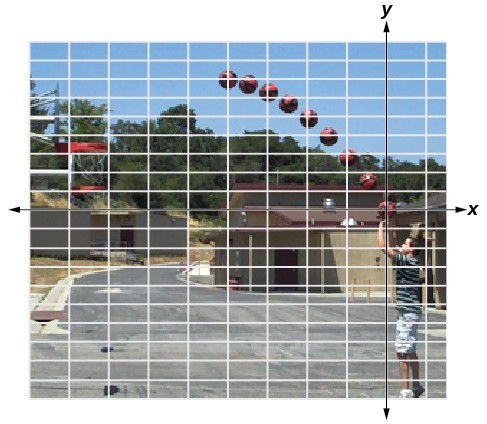Learning Objectives
- Graph vertical and horizontal shifts of quadratic functions
- Graph vertical compressions and stretches of quadratic functions
- Write the equation of a transformed quadratic function using the vertex form
- Identify the vertex and axis of symmetry for a given quadratic function in vertex form
The standard form of a quadratic function presents the function in the form
where [latex]\left(h,\text{ }k\right)[/latex] is the vertex. Because the vertex appears in the standard form of the quadratic function, this form is also known as the vertex form of a quadratic function.
The standard form is useful for determining how the graph is transformed from the graph of [latex]y={x}^{2}[/latex]. The figure below is the graph of this basic function.

Shift Up and Down by Changing the value of k
You can represent a vertical (up, down) shift of the graph of [latex]f(x)=x^2[/latex] by adding or subtracting a constant, k.
[latex]f(x)=x^2 + k[/latex]
If [latex]k>0[/latex], the graph shifts upward, whereas if [latex]k<0[/latex], the graph shifts downward.
Instructions:
- Use the slider in the interactive below to shift the graph of [latex]f(x)=x^2[/latex] down 4 units, then up 4 units.
- Use the textbox below the graph to write both transformed equations.
https://www.desmos.com/calculator/fpatj6tbcn
Make Note
Write the equation for the graph of [latex]f(x)=x^2[/latex] that has been shifted up 4 units in the textbox below.
Now write the equation for the graph of [latex]f(x)=x^2[/latex] that has been shifted down 4 units in the textbox below.
Now check yourself!
Shift left and right by changing the value of h.
You can represent a horizontal (left, right) shift of the graph of [latex]f(x)=x^2[/latex] by adding or subtracting a constant, h, to the variable x, before squaring.
[latex]f(x)=(x-h)^2 [/latex]
If [latex]h>0[/latex], the graph shifts toward the right and if [latex]h<0[/latex], the graph shifts to the left.
Instructions:
- Use the interactive graph below to shift the graph of [latex]f(x)=x^2[/latex] 2 units to the right, then 2 units to the left.
- Use the textbox below the graph to write both transformed equations
https://www.desmos.com/calculator/5g3xfhkklq
Make Note
Write the equation for the graph of [latex]f(x)=x^2[/latex] that has been shifted right 2 units in the textbox below.
Now write the equation for the graph of [latex]f(x)=x^2[/latex] that has been shifted left 2 units in the textbox below.
Now check yourself!
Stretch or compress by changing the value of a.
You can represent a stretch or compression (narrowing, widening) of the graph of [latex]f(x)=x^2[/latex] by multiplying the squared variable by a constant, a.
[latex]f(x)=ax^2 [/latex]
The magnitude of a indicates the stretch of the graph. If [latex]|a|>1[/latex], the point associated with a particular x-value shifts farther from the x-axis, so the graph appears to become narrower, and there is a vertical stretch. But if [latex]|a|<1[/latex], the point associated with a particular x-value shifts closer to the x-axis, so the graph appears to become wider, but in fact there is a vertical compression.
Instructions:
- Use the interactive graph below to make a graph of the function [latex]f(x)=x^2[/latex] that has been compressed vertically by a factor of [latex]\frac{1}{2}[/latex],
- And another that has been vertically stretched by a factor of 3.
- Use the textbox below the graph to write your equations.
https://www.desmos.com/calculator/ha6gh59rq7
Make Note
Write the equation for the graph of [latex]f(x)=x^2[/latex] that has been has been compressed vertically by a factor of [latex]\frac{1}{2}[/latex] in the textbox below.
Then, write the equation for the graph of [latex]f(x)=x^2[/latex] that has been vertically stretched by a factor of 3.
Now check yourself!
The standard form and the general form are equivalent methods of describing the same function. We can see this by expanding out the general form and setting it equal to the standard form.
For the linear terms to be equal, the coefficients must be equal.
This is the axis of symmetry we defined earlier. Setting the constant terms equal:
In practice, though, it is usually easier to remember that k is the output value of the function when the input is h, so [latex]f\left(h\right)=k[/latex].
Now you try it.
Use the interactive graph below to define two quadratic functions whose axis of symmetry is x = -3, and whose vertex is (-3, 2). Use the sliders for a, h, k below to help you.
https://www.desmos.com/calculator/pimelalx4i
Now answer the following questions about the graphs you made.
Take Note
How many potential values are there for h in this scenario?
How about k?
How about a?
Challenge Problem
Define a function whose axis of symmetry is x = -3, and whose vertex is (-3,2) and has an average rate of change of 3/2 on the interval [-2,0].
Here is the interactive graph again, if it helps.
https://www.desmos.com/calculator/pimelalx4i
Try It
A coordinate grid has been superimposed over the quadratic path of a basketball in the picture below. Find an equation for the path of the ball. Does the shooter make the basket?

(credit: modification of work by Dan Meyer)